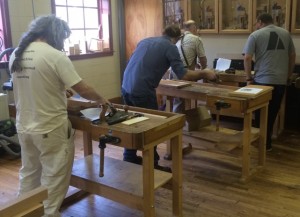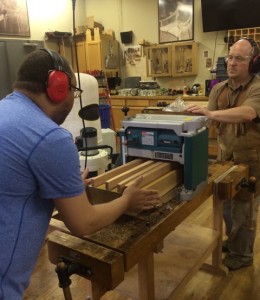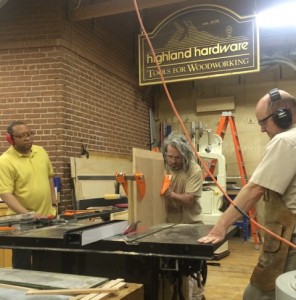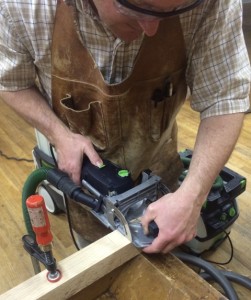One of the joys of taking a woodworking class is getting to do or see some technique you have read about and think you know, but have never actually done.
A good example was in the class I took at Highland a few weeks ago to build a Shaker Style End Table with instructor Jim Dillon. Jim works at the carpentry shop at Fernbank Science Center in Atlanta and teaches classes in the evenings at Highland. I don’t know if they let him work on the dinosaurs at Fernbank, but they probably should.
There are three big things I learned at the class with Jim :
The first is the hand planes. Now intellectually, I am very familiar with hand planes. You may think the same thing, in that you have read lots of books, and seen lots of videos, and watched Roy Underhill for years, but until you have seen and HEARD! someone use a sharp plane on a piece of wood, let me tell you, Buford, you have no idea. Most of us think the way you get a good finish on a piece of wood is to feed it through the electric thickness planer and then hit it with 320 sandpaper in the random orbit sander. You really need to get in a class with someone who has a properly sharpened hand plane and see the shimmering sheen left by a hand plane and those read-a-newspaper-through-it shavings. Once you can do that, there will be no sandpaper on your projects. One and done as they say.
The second thing was the tapering jig we used to taper the table legs. I have tapered legs before on the table saw with a tapering jig and it is not a comfortable situation. My hands are a little too close to the blade and I always felt like it was one step from total disaster. I wanted to call someone and say if you don’t get a call back from me in ten minutes, send the ambulance and the PortaJohn. As you can see in the photo, we had a tapering platform we ran through the thickness planer. It worked beautifully and is easily made. Simply double sticky tape the legs to the jig and keep running the jig through until the cutter head reaches the flat where the side aprons land. I think I remember it being 7/16” per foot taper. I like this tapering jig. No ambulance. No PortaJohn.
The third thing was the bevel on the edge of the table. We set this up so that the remainder edge on the table top was a quarter of an inch and then we wanted the bevel to be four inches wide. Since we had all planed our table tops by hand, none of them were the same thickness. There followed a pretty good discussion of how to make that work and the answer is the angle of the saw blade has to change slightly. If you hold the quarter inch remainder plus the four inch bevel on different thicknesses, then the angle is the only variable. You can see in the pictures that we set the table top on edge and clamped it to a fence riding jig for safety. (And I am truly deeply sorry for that fleeting one hundredth of a second when I thought what a great blog entry if someone tripped the SawStop.)
It was a real pleasure to use the SawStop Table Saw and the Festool DF 500 Q Domino Joiner, neither one of which I own or use. If I ever trade my table saw, the SawStop is top of my list. The Festool Joiner is more tool than I need in my little shop, but what a well-thought out, professional quality tool. It has every adjustment you could ever need and the Dominos were almost a drive fit when we installed them. The eighth inch reveal at the legs where the apron meets was a dial-in on the Festool and it worked perfectly.
Good class, well taught with good tools and techniques and well worth your money. Watch the class schedule for the next one and join in.





